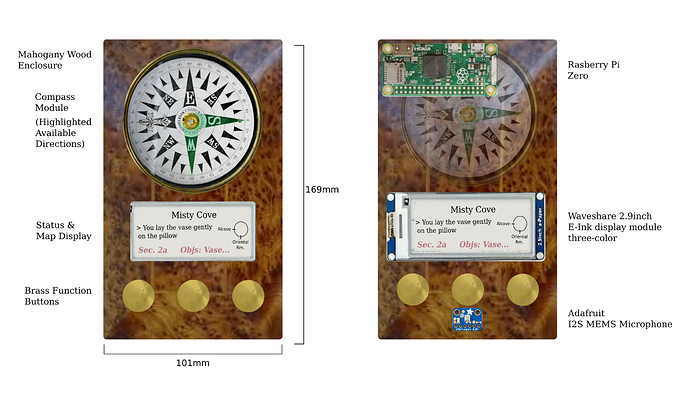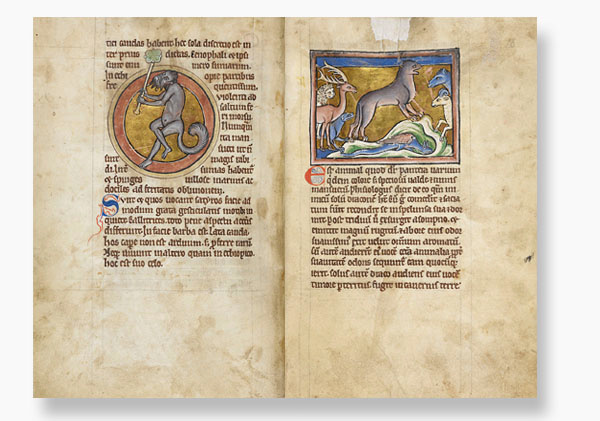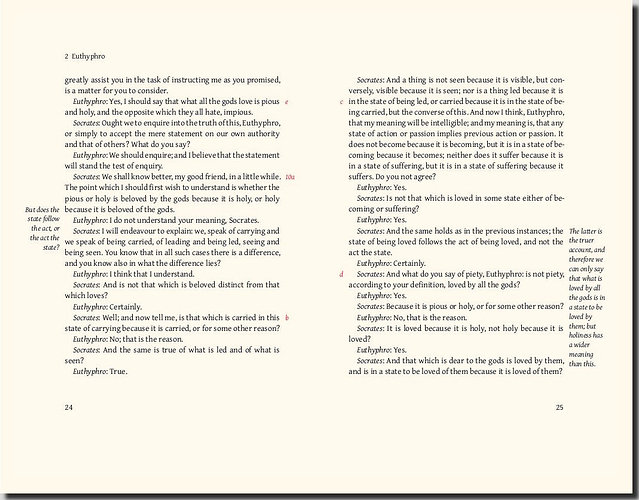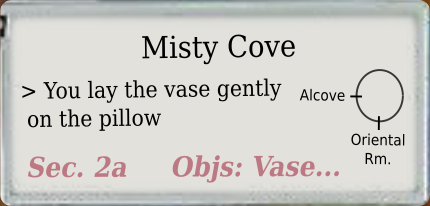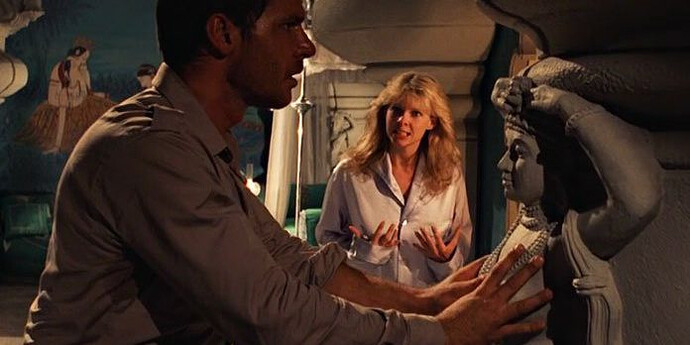Hi,
It took me three times reading your idea before the penny dropped. I kept thinking; instead of the device why not have an app, or instead of a book why not have an app.
Until, if i understand correctly, you’re suggesting a physical book not just in terms of resources (text, illustrations, maps etc), but as a solution workbook.
In other words the physical book would be both part of the story and for note taking and solving, where the player would actually write notes in specially reserved areas of the workbook. These could be pencil areas so that, in theory, they could be erased for re-playability.
So the idea is borne out of the fact that, for many styles of games, the player needs to write things down. In the old days, this tended to be a hand-drawn map and some clues. But, of course, this was unstructured and ad-hoc. This idea would formalise this process.
Here’s where i go off on a bit of a tangent…
Some time ago, i looked into the idea of whether there is a viable crossover space between story-based IF and logic puzzles.
If you imagine a continuum between the two, where on the one hand you have stories like novels in books, and on the other hand you have pure logic puzzles. I’m looking at something in between; kind of soft-brainiac plot-lead entertainment, typified by murder mysteries.
What do i mean by logic puzzles?
At the pure logic end, we have things like the Zebra Puzzle, ie a bunch of clues without any plot or explanations wherein you must solve a specific fact.
Examples like this are contrived, but people have made these sorts of puzzle into mysteries;
Example1: Murder at Brainteaser Mansion.
Ok, i admit, it’s not really a mystery, it’s a logic puzzle. But the idea is, could this sort of thing be made a bit softer, keep the element of logical mystery whilst also be entertaining. ie could it also be an IF game?.
Here are some others;
Example2: The Mysterious Murder of Mr. Mentum.
Example 3: Murder at Clue Mansion.
Example 4: Miss Brown Murder
Example 5: Sir Richard Murder.
There are scores of others. Some are quite cunning, like this.
You’ll notice that these are all examples of “grid solver puzzles”. You work through the clues applying positive and negative information to a grid until the grid is complete and the case is solved. After some practice you can get quite good at these and complete them quickly.
My idea was to make something a little more irregular than a pure grid, but nevertheless needed a note-taking approach to solve.
A bit like what i think is being suggested here with the workbooks.
Software
I investigated automated solvers for these and wrote a traditional grid solver and also how to solve these in Prolog.
For example, here’s my solution program for the temples;
:- use_module(library(clpfd)).
solve(Place, Year):-
Place = [Funai, Toyagi, Uchida, Usui],
Year = [Y1525, Y1585, Y1645, Y1705],
Hori #= 1,
Okabe #= 2,
Sama #= 3,
Takahashi #= 4,
init_dom(1..4,Place),
init_dom(1..4,Year),
% clue1
% Of the shrine in Uchida and the temple built in 1645, one is sama takako and the other is okabe honzo.
(Uchida #= Sama #/\ Y1645 #= Okabe) #\ (Y1645 #= Sama #/\ Uchida #= Okabe),
%clue 2
%The temple in Funai was built before takahashi
element(A, Year, Funai),
element(B, Year, Takahashi),
A #< B,
%clue 3
%The temple in toyagi was built 120 years before the temple in usui
element(C, Year, Toyagi),
element(D, Year, Usui),
D - C #= 2,
%clue 4
%Hori takesi was built after sama takako
element(E, Year, Hori),
element(F, Year, Sama),
E #> F,
labeling([], Place),
labeling([], Year).
init_dom(R, L) :-
all_distinct(L),
L ins R.
% solve(X,Y). to show indexes of Place and Year.
Turns out this can also be solved as a grid using my grid solver program
Thus;
#temples: hori_takesi, okabe honzo, sama takako and takahashi.
#locations: funai, toyagi, uchida and usui.
#dates are 1525, 1585, 1645 and 1705.
#You are given the following clues:
#1. Of the shrine in Uchida and the temple built in 1645, one is sama takako and the other is okabe honzo.
#2. The temple in Funai was built before takahashi
#3. The temple in toyagi was built 120 years before the temple in usui
#4. Hori takesi was built after sama takako
3
4
NAMES {The temple that}
Hori
Okabe
Sama
Takahashi
LOCATION {is in %s}{is not in %s}
Funai
Toyagi
Uchida
Usui
DATE {was built in %s}{was not built in %s}
1525
1585
1645
1705
#C1
uchida,1645,x
#c2
funai,takahashi,x
funai,1705,x
takahashi,1525,x
#c3
toyagi,1705,x
toyagi,1645,x # need at least 120 years
usui,1525,x
usui,1585,x # otherwise doesnt give enough 120 after
#c4
hori,1525,x
sama,1705,x
#from 3 either
#usui,1705,1
#toyagi,1585,1
# OR
#usui,1645,1
#toyagi,1525,1
# but from 1; sama != uchida, so;
#uchida,okabe,1
#sama,1645,1
# CONTRADICTION
#therefore, from 3
usui,1705,1
toyagi,1585,1
#from 2, takahashi is last
takahashi,1705,1
#from 4
sama,1645,x
#from 1; sama != 1645
uchida,sama,1
1645,okabe,1
# result
# LOCATION DATE
# funai toyagi uchida usui 1525 1585 1645 1705
#----------------------------------------------------------------------------
#hori x 1 x x x 1 x x
#okabe 1 x x x x x 1 x
#sama x x 1 x 1 x x x
#takahashi x x x 1 x x x 1
#-------------------------------------------
Here are my grid output for;
Example2
WEAPON ROOMS
candl gun knife poiso rope bedro conse dinin obser sitti
---------------------------------------------------------------------------
Fawn x 1 x x x 1 x x x x
Jake x x x x 1 x x x x 1
Kyle x x 1 x x x x x 1 x
Lance 1 x x x x x x 1 x x
Sara x x x 1 x x 1 x x x
--------------------------------------------
bedroom x 1 x x x
conservatory x x x 1 x
dining room 1 x x x x
observatory x x 1 x x
sitting room x x x x 1
and Example5
PLACE WEAPON
kitchen lounge bedroom twine dagger gun
----------------------------------------------------------------------------
burgandy.lord x 1 x x x 1
Green.lady x x 1 1 x x
whitehall.sir 1 x x x 1 x
---------------------------------------------
twine x x 1
dagger 1 x x
gun x 1 x
The others are just as easy except Example1, which actually is techically unsolvable!
Here is my partial grid for Example1:
TIME WEAPON MOTIVE CLUE
1 2 3 4 5 po re po ro da re ra bl gr je fo ha bl fi No
----------------------------------------------------------------------------
Rose.Mr x x x x x x x x x x 1
Tulip.Ms x x 1 x x x x x 1 x x x x
Daisy.Sir x x x x 1 x x x 1 x x x x x 1 x
Pansy.Lord x x x x x x x x x x 1 x x
Lily.Miss x x x 1 x x x x x x x x 1 x 1 x x x
------------------------------------------------------------
footprint x x 1 x x x x x
hair x x x 1 x x x x x x x x 1
blood spot x x x x x x x x
fingerprint x x x x 1 x x x 1 x x
Note x x x x x x
--------------------------------------------
revenge x x
rage x
blackmail x
greed x
jealousy x x x 1 x x x x
----------------------------
poison x x x
revolver x
pole x
rope x x x x 1
dagger x
It can also be coded in Prolog;
:- use_module(library(clpfd)).
solve(Time, Weapon, Motive, Clue, Villian) :-
Time = [T1, T2, T3, T4, T5],
Weapon = [Poison, Revolver, Pole, Rope, Dagger],
Motive = [Revenge, Rage, Blackmail, Greed, Jealousy],
Clue = [Footprint, Hair, Blood, Fingerprint, Note],
RoseM #= 1,
TulipF #= 2,
DaisyM #= 3,
PansyM #= 4,
LilyF #= 5,
init_dom(1..5,Time),
init_dom(1..5,Weapon),
init_dom(1..5,Motive),
init_dom(1..5,Clue),
Villian in 1..5,
% assume no one in meeting over 1 hour.
% clue1
woman(Footprint),
woman(Poison),
element(A, Time, RoseM), element(B, Time, Poison), B-A #= 1,
B #< 5,
%clue 2
Revolver #= TulipF,
Revenge #\= TulipF,
element(C, Time, TulipF), E #= C + 1, element(E, Time, D), man(D), (D #= Rage #\/ D #= Blackmail),
%clue 3
Fingerprint #= DaisyM,
LilyF #= Hair,
element(F, Time, DaisyM), element(G, Time, Pole),
F - G #> 1,
%clue 4
element(H, Time, PansyM), I #= H-1, element(I, Time, J), woman(J),
Rope #\= J,
Rope #= T5,
PansyM #\= Greed,
PansyM #\= Blackmail,
%clue 5
LilyF #= Jealousy,
man(Blackmail),
element(K, Time, LilyF), L #= K+1, element(L, Time, M), man(M), M #= Blood,
element(N, Time, Blackmail), N #< 4,
%additional
element(P, Weapon, Villian), element(Q, Time, Villian), (P #> 1) #==> (Q #= 5),
labeling([], Time),
labeling([], Weapon),
labeling([], Motive),
labeling([], Clue),
indomain(Villian).
man(X) :-
X #= 1 #\/ X #= 3 #\/ X #= 4.
woman(X) :-
X #= 2 #\/ X #= 5.
init_dom(R, L) :-
all_distinct(L),
L ins R.
% run with
% solve(T,W,M,C,V).
% not enough information given, but will enumerate remaining possiblities
Which is interesting because Prolog can accommodate logic that is not just a pure grid. It can also enumerate remaining possibilities.
Here’s the output;
1 ?- solve(T,W,M,C,V).
T = [1, 5, 4, 2, 3],
W = [5, 2, 1, 3, 4],
M = [4, 3, 1, 2, 5],
C = [2, 5, 4, 3, 1],
V = 3 ;
T = [1, 5, 4, 2, 3],
W = [5, 2, 1, 3, 4],
M = [4, 3, 1, 2, 5],
C = [2, 5, 4, 3, 1],
V = 5 ;
T = [1, 5, 4, 2, 3],
W = [5, 2, 4, 3, 1],
M = [4, 3, 1, 2, 5],
C = [2, 5, 4, 3, 1],
V = 3 ;
T = [1, 5, 4, 2, 3],
W = [5, 2, 4, 3, 1],
M = [4, 3, 1, 2, 5],
C = [2, 5, 4, 3, 1],
V = 5 ;
T = [2, 1, 5, 4, 3],
W = [5, 2, 1, 3, 4],
M = [3, 4, 1, 2, 5],
C = [2, 5, 4, 3, 1],
V = 3 ;
T = [2, 1, 5, 4, 3],
W = [5, 2, 1, 3, 4],
M = [3, 4, 1, 2, 5],
C = [2, 5, 4, 3, 1],
V = 5 ;
T = [2, 1, 5, 4, 3],
W = [5, 2, 1, 3, 4],
M = [4, 2, 1, 3, 5],
C = [2, 5, 4, 3, 1],
V = 3 ;
T = [2, 1, 5, 4, 3],
W = [5, 2, 1, 3, 4],
M = [4, 2, 1, 3, 5],
C = [2, 5, 4, 3, 1],
V = 5 ;
T = [2, 1, 5, 4, 3],
W = [5, 2, 1, 3, 4],
M = [4, 3, 1, 2, 5],
C = [2, 5, 4, 3, 1],
V = 3 ;
T = [2, 1, 5, 4, 3],
W = [5, 2, 1, 3, 4],
M = [4, 3, 1, 2, 5],
C = [2, 5, 4, 3, 1],
V = 5 ;
false.
So where am i going with this?
Make an entertaining story whose core is a “soft” logic problem (ie one based in plot-related facts not contrived ones). Make sure there are more clues than strictly needed, reveal the clues bit by bit. Allow the player to make notes, until the solution becomes clear.
The bit about more clues than needed is crucial. In pure logic problems like those above, you are only given strictly what’s necessary and sufficient to solve the problem, with no luxury of slack. That’s why some of the hard puzzles are hard - because you need to figure every single fact to solve it.
The idea for IF/puzzle crossover is that you don’t do that. Instead you keep giving the player clues until everybody can solve the problem, no matter their skill level. Of course this also drives the score. Players who solve in less clues score more than those who take more clues.
It’s also entertaining because you can’t get stuck and it’s suitable for beginners and experts alike.
How does this relate to the compass device?
The compass device is the automation of the story in terms of its state and the revelation of clues. It’s basically the game driver, which you would need for a dynamic clue game suitable for all players.
If there was only the book, then you could just read all the clues upfront and there would be no entertainment.
How does this relate to having a physical book
The book is also a workbook. It replicates the purpose of the grid worksheets needed in the pure logic puzzles above. But it is not organized as grid, but a taker of notes in a structured way. So it needs to show how some facts can be used to deduce others without being represented as an off-putting technical grid.
It also lets you make these notes on the pages with information, maps, illustrations etc.
Tangent over 
PS. If you think i’ve missed something in Example 1, let me know!
